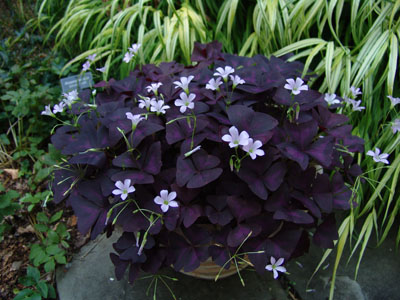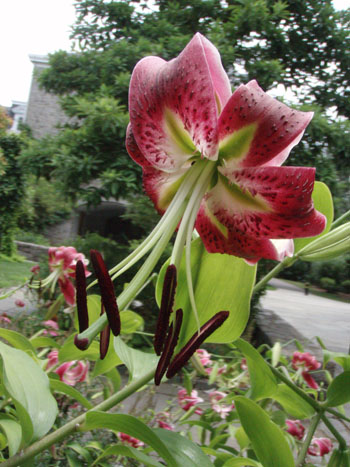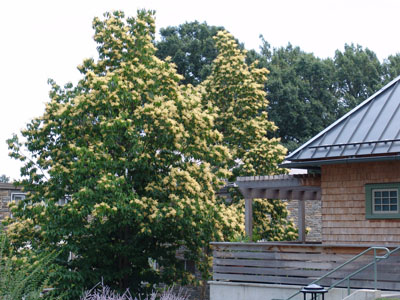Plants of the Week – July 16
 Welcome! Although Eucomis not a real pineapple, its flower stalks with perfectly arranged star-like flowers closely resemble a pineapple. So, as the pineapple is a sign of welcome, it is fitting that Eucomis lines the front walk to the Arboretum Offices. Eucomis comosa ‘Sparkling Burgandy’, commonly called the pineapple lily, is a species of African bulb in the Asparagaceae family. The bulbs will emerge in spring, grow rapidly, bloom in summer and then keep attractive round seedpods until frost. Besides using it as a symbol of welcome, it makes a unique plant for the garden with its thick glossy foliage and summer-blooming flowers. They are nice for sunny areas as they prefer full sun yet do not need much watering. Photo Credit: J. Ahrweiler
Welcome! Although Eucomis not a real pineapple, its flower stalks with perfectly arranged star-like flowers closely resemble a pineapple. So, as the pineapple is a sign of welcome, it is fitting that Eucomis lines the front walk to the Arboretum Offices. Eucomis comosa ‘Sparkling Burgandy’, commonly called the pineapple lily, is a species of African bulb in the Asparagaceae family. The bulbs will emerge in spring, grow rapidly, bloom in summer and then keep attractive round seedpods until frost. Besides using it as a symbol of welcome, it makes a unique plant for the garden with its thick glossy foliage and summer-blooming flowers. They are nice for sunny areas as they prefer full sun yet do not need much watering. Photo Credit: J. Ahrweiler
 Though the common name for Oxalis regnellii is Purple Shamrock, this plant is not related to clover, which is the smaller, similarly foliated plant which is commonly found in lawns. Oxalis regnellii ‘Purpurea’, is a beautiful ornamental perennial in the Oxalidaceae family with deep purple triangular leaves. It blooms spring through summer, projecting little pink star-shaped flowers above its foliage which look charming against the purple back drop. If you cut back the entire plant it will bloom continuously throughout the summer. Oxalis regnellii is pretty easy to take care of, but there are things you can do to ensure success. It likes cool air and moist soil while it is growing and prefers bright but indirect light. Also, if used as an indoor plant it might go dormant in the winter and lose some leaves. But don’t worry! Let it be dormant for around three weeks and then it will refresh itself. I love this plant in container gardens, its foliage making a nice filler, though it could also be used in the landscape. Photo Credit: J. Ahrweiler
Though the common name for Oxalis regnellii is Purple Shamrock, this plant is not related to clover, which is the smaller, similarly foliated plant which is commonly found in lawns. Oxalis regnellii ‘Purpurea’, is a beautiful ornamental perennial in the Oxalidaceae family with deep purple triangular leaves. It blooms spring through summer, projecting little pink star-shaped flowers above its foliage which look charming against the purple back drop. If you cut back the entire plant it will bloom continuously throughout the summer. Oxalis regnellii is pretty easy to take care of, but there are things you can do to ensure success. It likes cool air and moist soil while it is growing and prefers bright but indirect light. Also, if used as an indoor plant it might go dormant in the winter and lose some leaves. But don’t worry! Let it be dormant for around three weeks and then it will refresh itself. I love this plant in container gardens, its foliage making a nice filler, though it could also be used in the landscape. Photo Credit: J. Ahrweiler
 Oriempet lilies, crosses between Oriental and trumpet and Aurelian hybrids, are a relatively new type of lily. These lilies were bred to have the beauty of the Oriental lily and the heat tolerance, garden persistence, and range of color of the trumpet lilies. The oriempet lily Lilium ‘Black Beauty’ is the original clone, bred by Dr. Leslie Woodriff nearly 50 years ago. It was the first of its kind and is considered a big step in lily breeding. Now ‘Black Beauty’ graces our gardens with its famous black and red flowers and tightly curled-back petals. It is extremely hardy, flourishes in every climate and if happy reproduces to create large colonies. Now, they can be seen in bloom in our Scott Entrance Garden and in Cosby Courtyard. Photo Credit: J. Ahrweiler
Oriempet lilies, crosses between Oriental and trumpet and Aurelian hybrids, are a relatively new type of lily. These lilies were bred to have the beauty of the Oriental lily and the heat tolerance, garden persistence, and range of color of the trumpet lilies. The oriempet lily Lilium ‘Black Beauty’ is the original clone, bred by Dr. Leslie Woodriff nearly 50 years ago. It was the first of its kind and is considered a big step in lily breeding. Now ‘Black Beauty’ graces our gardens with its famous black and red flowers and tightly curled-back petals. It is extremely hardy, flourishes in every climate and if happy reproduces to create large colonies. Now, they can be seen in bloom in our Scott Entrance Garden and in Cosby Courtyard. Photo Credit: J. Ahrweiler
 Poliothyrsis sinensis is a tree of interest right now as one of the few trees displaying summer interest. Its canopy is full of bushy yellowish-white flowers providing color whereas other trees are often showiest in spring and fall. This is a medium-sized tree and useful in the landscape beyond its summer blooms as it is decently dry-tolerant and can withstand adverse conditions. In fact, it might make a good street tree. We have one in the entrance garden, displayed against the copper observatory dome, and two more next to the Wister Center. Photo Credit: J. Ahrweiler
Poliothyrsis sinensis is a tree of interest right now as one of the few trees displaying summer interest. Its canopy is full of bushy yellowish-white flowers providing color whereas other trees are often showiest in spring and fall. This is a medium-sized tree and useful in the landscape beyond its summer blooms as it is decently dry-tolerant and can withstand adverse conditions. In fact, it might make a good street tree. We have one in the entrance garden, displayed against the copper observatory dome, and two more next to the Wister Center. Photo Credit: J. Ahrweiler





Eunice
Posted at 15:41h, 19 JulyThe only thing that would make this blog better would be to include the pronunciations of the botanical names.
Lilah
Posted at 19:48h, 25 JulyThat purple shamrock is gorgeous! I am going to have to try my hand at growing it.
http://www.genericseeds.com/
John Schucker
Posted at 12:21h, 01 AugustI notice that Lillium ‘Black Beauty’ is referred to as an oriempet lily. At first I thought it was just a typo, but I notice it is spelled twice that way. I believe the term is actually orienpet, no? I have never seen this type of hybrid referred to as oriempet, but I actually prefer that spelling, now that I have tried pronouncing it that way. It seems a slightly more elegant combination of the two terms suited to these most elegant plants. I did not realize ‘Black Beauty’ falls into this category of lily.
Josh Coceano
Posted at 15:27h, 01 AugustJohn,
Good eye. It should indeed read orienpet for the oriental and trumpet lily parentage. ‘Black Beauty’ never fails to catch attention and is always reliable. We are looking into adding more orienpet cultivars to the arboretum.